Krull (film)
4.6 /10 1 Votes
33% Rotten Tomatoes Genre Action, Adventure, Fantasy Budget 50 million USD Language English | 6/10 IMDb Duration Country United KingdomUnited States | |||||||||||||||||||||||||||||||||
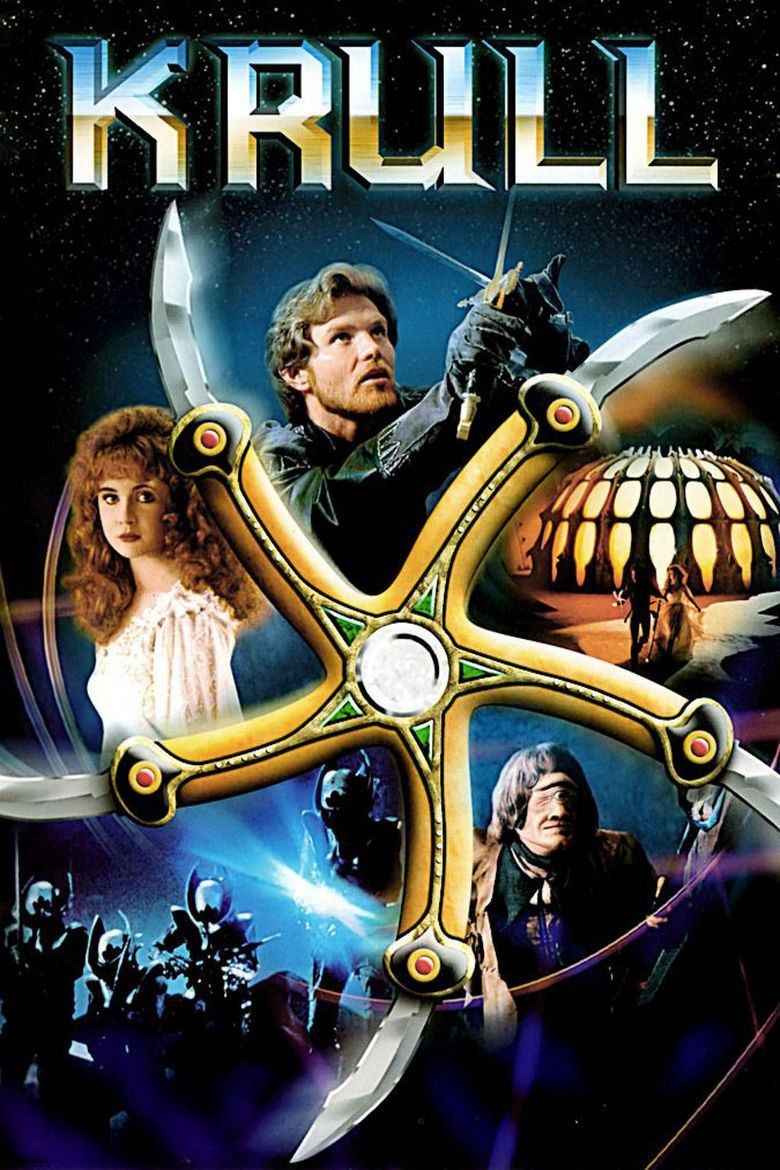 | ||||||||||||||||||||||||||||||||||
Release date 29 July 1983 (1983-07-29) (United States)27 December 1983 (1983-12-27) (United Kingdom) Cast (Prince Colwyn), (Princess Lyssa), (Lyssa, Widow of the Web), (Torquil), (Ergo), (Rell the Cyclops) Similar movies Shrek the Third , The Little Mermaid , In the Name of the King: A Dungeon Siege Tale , Stardust , DragonHeart: A New Beginning , Ran Tagline A world light-years beyond your imagination. | ||||||||||||||||||||||||||||||||||
Krull 4 8 movie clip battle in the swamps 1983 hd
Krull is a 1983 British-American science fantasy swashbuckler film directed by Peter Yates and produced by Ron Silverman with a screenplay by Stanford Sherman. It follows a journey of Prince Colwyn and his group of outlaws on the planet Krull to save future queen Princess Lyssa from a creature named "The Beast" and his constantly transporting lair named the "Black Fortress." The film began development in 1980 when Columbia Pictures present Frank Price gave Silverman the idea to produce a fantasy film and was finally released in July 1983. Yates' work on Krull differed from directing his previous films that were more realistic; he took the "challenge" of directing a motion picture like Krull since he only could rely on his imagination instead of doing research, and screenplays that encouraged experimentation with modern special effects were rare in the early 1980s.
Contents
- Krull 4 8 movie clip battle in the swamps 1983 hd
- Krull 8 8 movie clip burning tracks 1983 hd
- Plot
- Cast and characters
- Development
- Settings and locations
- Filming and directing
- Special effects
- Music
- Analysis
- Critical opinion
- Designs and special effects
- Soundtrack
- Writing
- Characters and performances
- Awards
- Adaptations
- Video games
- Home media
- References
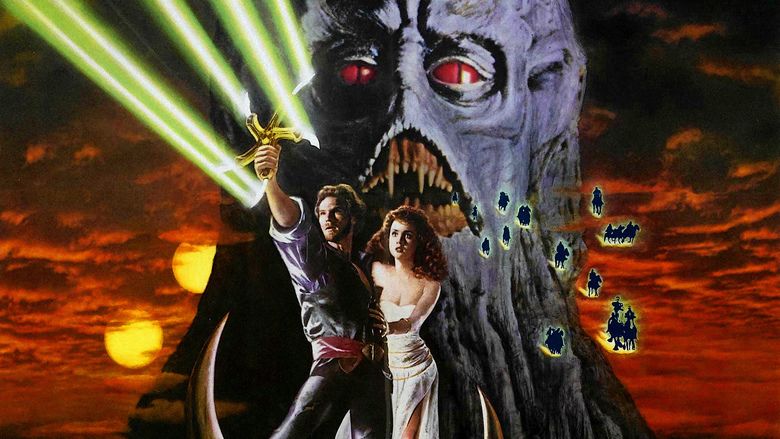
Krull consists of an ensemble cast of Ken Marshall as Prince Colwyn, Lysette Anthony as Princess Lyssa, Trevor Martin as the voice of the Beast, Freddie Jones as Ynyr, Bernard Bresslaw as Rell the Cyclops, David Battley as Ergo the Magnificent, Tony Church and Bernard Archard as kings and the fathers of Colwyn and Lyssa, Alun Armstrong as the leader of a group of bandits that include early screen roles for actors Liam Neeson and Robbie Coltrane, John Welsh as The Emerald Seer, Graham McGrath as Titch, and Francesca Annis as The Widow of the Web.
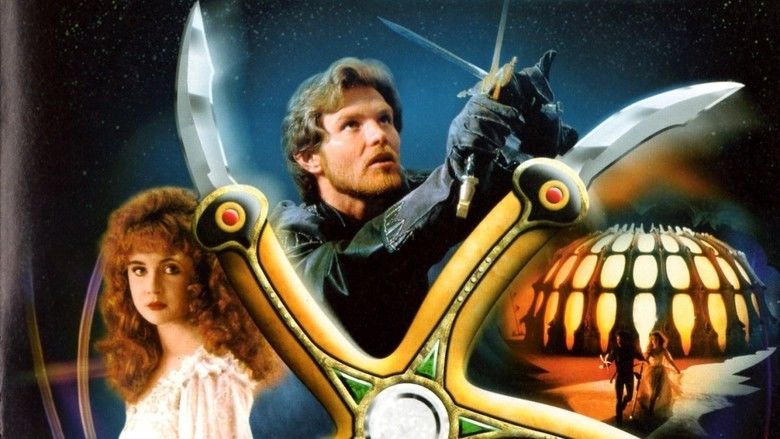
Krull went through a very expensive, harsh, and dangerous production process. The film's huge budget mainly came from the designers having to make numerous alterations to the sets. Krull was shot at numerous sound stages at Pinewood Studios, and actors such as Marshall, Bernard Bresslaw, and Freddie Jones had to achieve dangerous and deadly stunts during filming. Despite these efforts, the film was a commercial failure upon release, and critical opinion, both upon release and in retrospect, has been mixed. Numerous reviewers have highlighted its visual effects and soundtrack, while several critics have criticized its derivative and nonsensical plot. However, the film has gone on to achieve the status of a cult film.
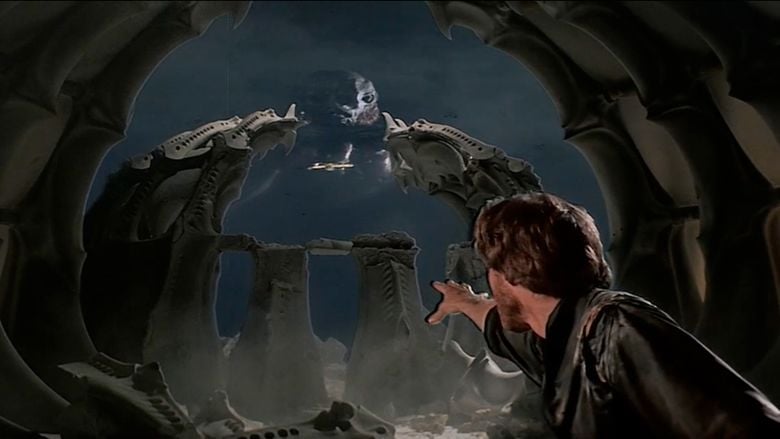
Krull 8 8 movie clip burning tracks 1983 hd
Plot

A narrator describes a prophecy regarding "a girl of ancient name that shall become queen", which says "that she shall choose a king, and that together they shall rule their world, and that their son shall rule the galaxy".
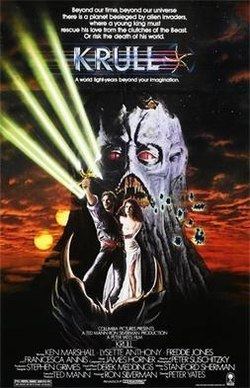
The planet Krull is invaded by an entity known as the "Beast" and his army of futuristic "Slayers", who travel the galaxy in a mountain-like spaceship called the Black Fortress. In a ceremony involving exchanging a handful of flame between the newlyweds, Prince Colwyn and Princess Lyssa plan to marry and form an alliance between their rival kingdoms in the hope that their combined forces can defeat the Beast's army. The Slayers attack the wedding before it is completed, killing the two kings, devastating both armies and kidnapping the princess.

Prince Colwyn is found and nursed by Ynyr, the Old One. Ynyr tells him the Beast can be defeated with the "Glaive", an ancient, magical, five-pointed throwing weapon. Colwyn retrieves the Glaive from a high mountain cave before setting out to track down the Black Fortress, which teleports to a new location every day at sunrise. As they travel, Colwyn and Ynyr are joined by magician Ergo "the Magnificent" and a band of nine thieves, fighters, bandits and brawlers. Colwyn offers to clear their criminal records, successfully enlisting Torquil, Kegan, Rhun, Oswyn, Bardolph, Menno, Darro, Nennog and Quain. The cyclops Rell later joins the group.

Colwyn's group travels to the home of the Emerald Seer, and his apprentice Titch. The Emerald Seer uses his crystal to view where the Fortress will rise, but the Beast's hand magically appears and crushes the crystal. The group travels to a swamp that cannot be penetrated by the Beast's magic, but Slayers attack, killing Darro and Menno, and also the Emerald Seer, before he can confirm the next location of the Fortress.
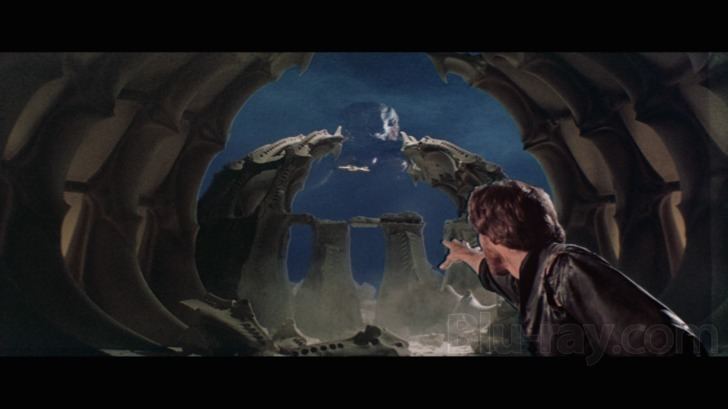
While the group rests in a forest, Kegan goes to a nearby village and gets Merith, one of his wives, to bring food. The Beast exerts remote command of Merith's helper, who attempts to seduce then kill Colwyn, but fails. Ynyr leaves the resting group to journey to the "Widow of the Web", an enchantress who loved Ynyr long ago and was exiled to the lair of the Crystal Spider for murdering their only child. The Widow reveals where the Black Fortress will be at sunrise. She also gives Ynyr the sand from the enchanted hourglass that kept the Crystal Spider from attacking her and will keep a badly injured Ynyr alive on his journey back to the group. As the Crystal Spider attacks the Widow, Ynyr flees the web and returns to the group to reveal the location of the Black Fortress; as he speaks, he loses the last of the sand and expires.
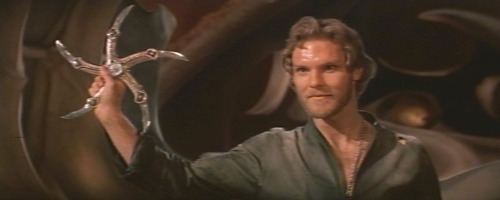
The group capture and ride magical Fire Mares to reach the Black Fortress before it teleports again. Slayers at the Fortress kill Rhun, while Rell sacrifices himself to hold open the crushing spaceship doors long enough to allow the others to enter. Slayers inside kill Quain and Nennog, and Kegan sacrifices his life to save Torquil as they journey through the Fortress. When Ergo and Titch get separated from the others and are attacked by Slayers, Ergo magically transforms into a tiger to kill the Slayers and save Titch's life.
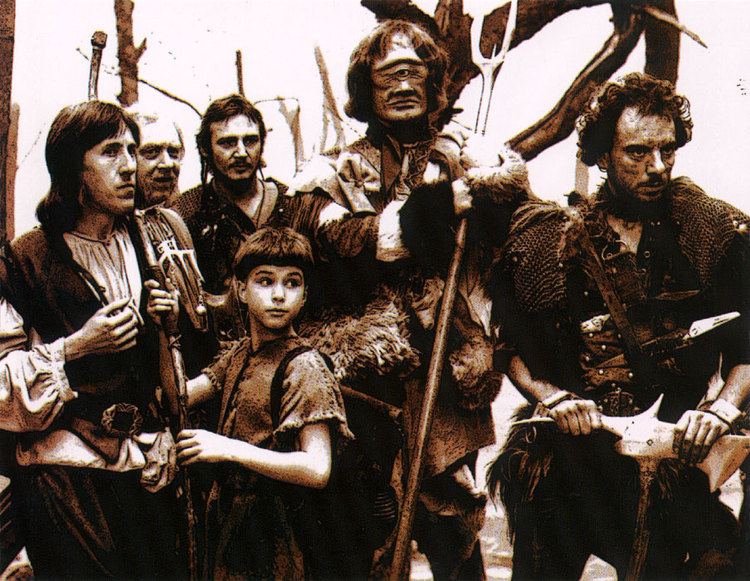
Colwyn, Torquil, Bardolph and Oswyn are trapped inside a large dome. Colwyn attempts to open a hole in the dome with the Glaive, while the other three search for any other passageway. The three fall through an opening and are trapped between slowly closing walls studded with huge spikes, which kill Bardolph.
Colwyn breaches the dome and finds Lyssa. He attacks the Beast, injuring it with the Glaive, which becomes embedded in the Beast's body. With nothing to defend themselves against the Beast's counterattack, Lyssa realizes that they must quickly finish the wedding ritual, giving them the linked power to shoot flame, with which they finally slay the Beast. Its death frees Torquil and Oswyn from the spike room and they rejoin Colwyn and Lyssa, then Ergo and Titch, as they make their way out the self-destructing Fortress.
Colwyn and Lyssa, now king and queen of the combined kingdom, name Torquil as Lord Marshal. As the surviving heroes depart across a field, the narrator (Ynyr) repeats the opening prophecy that the son of the queen and her chosen king shall rule the galaxy.
Cast and characters
Development
In 1980, the president of Columbia Pictures Frank Price asked producer Ron Silverman if he and his partner Ted Mann wanted to create a fantasy film. Silverman agreed to do so and hired Stanford Sherman, whose previously well-known writing credit was Any Which Way You Can (1980), to work on the screenplay. He wrote the "bare bones" of the plot and sent it to Colombia, which they quickly approved. While the essence of the plot was never altered during development and production, the first draft of the film was titled The Dragons of Krull, where The Beast was initially planned to be a dragon; however, the creators changed The Beast to a more "reptilian" creature, as Sherman described him, for the final film, leading to the title change from The Dragons of Krull to simply Krull.
The team also brought in Steve Tesich to write a "second version" of the script. Tesich's version of the screenplay was discarded given that it was more dialogue-heavy, less action-orientated, and gave the directors and producers nearly zero opportunities to work with special effects, so the first script was used and re-edited instead. There was one point in the writing process where it was planned that Lyssa would turn into the antagonist near the end of the story, but this was not part of the final screenplay given that the production team didn't want her to be "less than pure." Lysette Anthony, the actress who played Lyssa, explained that she "thought that was a little boring."
After the first draft was finished, Krull's writing and production team first considered Peter Yates to direct the film. Two months after they asked him to join the project and after he finished work on directing Eyewitness (1981), Yates read the screenplay of The Dragons in Krull. He was "intrigued" with what he read and accepted the position of directing the film as a "challenge." He reasoned in a 1983 interview that Krull would be one of those rare films that "can take full advantage of today's special effects techniques" and would differ from Yates' more realistic previous works in that, instead of having to research, he would have to make the movie entirely based on his imagination. The film was in a year of pre-production, which involved Sherman editing the script, Yates creating storyboards, Stephen B. Grimes and Derek Meddings coming up with and drawing set concepts, and Ken Marshall and Anthony being cast as Colwyn and Lyssa respectively.
Despite persistent rumours that the film was meant to tie-in with the game Dungeons & Dragons, Gary Gygax stated that "To the best of my knowledge and belief the producers of Krull never approached TSR for a license to enable their film to use the D&D game IP."
Settings and locations
Because Krull was first planned as a medieval-style motion picture, the production team initially arranged it to be shot at several locations. However, as it went through multiple drafts, the screenplay transformed into a story that was entirely fantasy, which meant most of the film would be shot on sound stages and only a minority of the sequences would be filmed in actual locations in Italy and England for only a few weeks. 23 huge sets of the film were built and shot at over ten sound stages at Pinewood Studios. Krull was a very expensive film to produce, using a budget of $30 million according to Starlog magazine. Marshall and Meddlings reasoned that the huge budget was due to several changes of concepts in the script that led the designers to have to alter the designs of the sets multiple times.
Starlog critic Lawrence Watt-Evans analogized the look, story, and vibe of Krull as a superior version of The Dark Crystal (1982). As he described the film's settings:
Basically medieval in appearance, Krull has a sort of streamlined look in places, as if perhaps its civilization is more technologically advanced than it appears on the surface. The Black Fortress and everything connected with it has a broken, vaguely organic look to it, as if it were grown instead of built— and then cut to shape where it hadn't grown right. The interior is quite weird, and seems to be constantly shifting to suit the 'whims of the Beast.
Filming and directing
Yates described making Krull as "complicated" and "just so enormous," and special effects artist Brian Johnson stated in a 2009 interview that Yates hated working on the film so much that in the middle of shooting, he took a vacation to the Caribbean which led to the special effects artists taking a three-week break from the project.
Filming began on 25 January 1983. The first sequence shot was the scene where Ynyr climbs on a huge spider web in order to confront the Widow of the Web. It involved Freddie Jones, who played Ynyr, not using any safety wires when he climbed the huge web because the wires would have otherwise been visible. Stop-motion animator Steve Archer, who previously worked on Clash of the Titans (1981), spent two weeks creating the first model of the spider in the scene which was later scrapped and changed.
Yates' direction of the action scenes that take place in the beginning of Krull were inspired by swashbuckler films such as Captain Blood (1935). However, he wanted to go through the "complicated" process of figuring out new weapons that gave the scenes a unique swashbuckling feel. Marshall practiced his moves for the sequences a week before filming of them began. However, by the time shooting of these scenes started, the costumes for the Slayers were recently finished; therefore, much of the fight choreography was altered based on the limitations of the costumes at the last minute.
Pinewood's 007 Stage, one of the largest sound stages across the globe, was used for the swamp scene of Krull, where the Slayers and several changelings encounter Colwyn and his group. Yates described the swamp set as "quite nasty," and "we always had people bumping into things." It was filmed during what Marshall called a "very harsh winter" of 1983, and the set was too big to be entirely heated, leading to the actors feeling cold and "exhausted." The crew members had a hard time seeing through the mist, which led them accidentally getting into water that consisted of "cork chips."
Rehearsing the scene where Colwyn and his group are in the lair of The Beast being chased by the Slayers involved stuntmen taking the part of Colwyn so that Marshall could obtain enough energy for filming it. It involved Colwyn and his men encountering a corridor where the floor opened underneath them via two set pieces "the size of a small house" that were powered by liquid and broke apart before quickly slamming back together. A few of the men got trapped into the tunnel that the floor opened to. As a result, Colwyn was required to use a rope to get the men out of the tunnel. However, as he got into the hole, the set pieces began to come together and Colwyn and the trapped men had to rush back before the sides slammed into each other again.
Marshall explained that doing the sequence gave him nightmares after it was completed. When shooting of the scene began, Marshall took more time to say his lines than the production crew expected, leading to him not making it from the tunnel in the first take. Only one crew member noticed this and was able to stop the machines controlling the pieces, but Marshall explained that he "knew that if the machine didn't stop in five seconds, [he] would be dead." Another take of the sequence was shot the next day with Yates instructing that the speed of the machine be slower. However, Marshall insisted the machine being sped up and in the final take was successful in getting away from the two set pieces alive. As Marshall explained, "I had no feeling in my heel for months afterward. It was really hard doing stunts afterwards, too."
Special effects
Meddings, who was previously known for his work on Superman (1978) and its 1980 sequel, led the special effects department of Krull. British artist Christopher Tucker was also originally in the project but left due to creative differences. Nick Maley and his crew produced several effects six weeks before filming began. The effects department of Krull went for challenges in making visual effects and designs that were unusual to achieve in the early 1980s. As Meddings described how the special effects were made for the movie:
It was a hard show in terms of effects. Whenever you do an effects picture, you try to come up with something new. Unfortunately, you don't always succeed. You may think you've done something amazing, but, ultimately, it's up to the audience for that verdict. We really worked ourselves silly on this one, though.
Meddings created miniatures for the setting of the film's titular planet. The model of Lyssa's castle Meddings constructed was twenty-feet high, so shots of it were done in Italy using forced perspective to make it look taller than it really was. The design of The Beast's Black Fortress had a height of twelve feet, and electrical wiring was used to execute the light within it. Because the Black Fortress disintegrates at the end of the film, it was constructed "like a jigsaw puzzle with parts able to be pulled apart on cue."
In Krull, Ergo uses his magic to transform into other creatures such as puppies and geese. Meddings used an effects strategy in showing these transformations different from traditional cross dissolve methods, reasoning that it had "been done to death." He explained:
We did it with a series of blow-ups embellished with artwork so that you could actually blend in the actor. The actor [David Battley] dropped down to his knees and we used a series of blow-ups to reduce him to puppy size. Then, halfway through the transition, we introduced blowups of the puppy, blending the two sets together with artwork. Then, as the last still went on screen, we substituted the real dog who just wagged his tail and walked away. It was a trick, but it looks quite magical.
Music
The film score was composed by James Horner and performed by The London Symphony Orchestra and the Ambrosian Singers. It has been commended as part of the composer's best early efforts before his more famous post-1990 era works.
The score features traditional swashbuckling fanfares, an overtly rapturous love theme and other musical elements that were characteristic of fantasy/adventure films of the 1980s, along with incorporating avant-garde techniques with string instruments to represent some of the monstrous creatures in the story. Additionally, to accompany the main antagonists, the Beast and its army of Slayers, Horner utilised Holst-like rhythms and groaning and moaning vocals from the choir. Also of note is a recurring "siren call" performed by female voices that starts and bookends the score, and appears numerous times in the story to represent the legacy of the ancient world of Krull.
Horner's score is reminiscent of earlier works, particularly Star Trek II: The Wrath of Khan. Some pieces of the music were reused for the area atmosphere nearby: Space Mountain: From the Earth to the Moon (1995–2005)—now Space Mountain: Mission 2—at Disneyland Paris.
The score has been released numerous times on album by various labels. The first was a 45-minute condensed edition, which was released by Southern Cross Records in 1987, featuring most of the major action cues, three renditions of the love theme, and the music from the end credits; however, music from the main title sequence was omitted. Southern Cross Records later released special editions in 1992 and 1994 (the latter a Gold disc) with a running time of over 78 minutes, expanding on all of the previously released tracks, featuring the main title music and other action cues.
In 1998, SuperTracks released the complete recorded score in a two-CD set with elaborate and attractive packaging and extensive liner notes by David Hirsch; this release, and the 1992 and 1994 releases, have become rare and very expensive collectible items. In 2010, La-La Land Records re-issued the SuperTracks album, with two bonus cues and new liner notes by Jeff Bond in a limited edition of 3,000 copies, which sold out within less than a year. La-La Land reissued an additional 2,000 copies of the album in 2015.
Analysis
Combining elements of sword and sorcery and the space opera genre, Krull has a plot compared by critics to the works in the series of Star Wars, The Lord of The Rings, and, for its use of the Glaive, the legend of King Arthur. Watt-Evans explained that the Glaive is "just there, waiting for the right man to come and wield it." Despite most of the characters saying they know about the myths of the Glaive, they never reveal these stories to Colwyn before he obtains the weapon. As Watt-Evans, wrote "Do any of the stories ever bother to explain who forged Excalibur, or how? No, it's just there, waiting for Arthur to come and get it. Similarly, the Glaive is just there, waiting for Colwyn."
The type of film Yates went for with Krull was "sort of a fairy storybook that moves; a fairy tale with a life, a reality of its own. I very much wanted to make a movie with some old-fashioned romance to it, yet a movie where things always moved." Watt-Evans, categorizing Krull as a fairy tale, noted the film to be mythic to the point of having "no attempt at realism." As he analyzed, "Lyssa and Colwyn, despite having apparently arranged the marriage for political reasons, fall madly in love at first sight." He also analyzed, "although we're told that the Slayers have been burning villages, we never see a village, burned or otherwise." He also wrote that establishing shots of castles show no residents or plot-unrelated extras passing by; this was an indication that the lands of Krull do not have an economic system or population, which was appropriate given that "it's traditional for the heroes of fairy tales to be unbothered by such necessities as food and shelter." He also wrote that not much about the background of the characters are revealed because "this is not a film that explores the innermost secrets of the human heart, it's a glorious fairy tale for both adults and children."
None of the characters who live on Krull also explain the magical powers they use everyday. Watt-Evans wrote that this lack of explanation "helps one to accept that these people are real people, living in a real world." He reasoned that magic powers are Krull's equivalent to automobiles: "in a movie set on Earth, does anyone bother to explain cars? No, they're just there. For Krull, magic is as much a part of the everyday world as automobiles are for us."
Critical opinion
Krull currently holds a 33% rating on Rotten Tomatoes based on 24 reviews. The film made over $16.5 million in the U.S., failing to bring back its reported budget of over $45–50 million. However, it has gained a cult following over the years since its release. Variety called Krull a "blatantly derivative hodgepodge of Excalibur meets Star Wars." However, they also opined that the "professionalism of director Peter Yates, the large array of production and technical talents and, particularly, the mainly British actors keep things from becoming genuinely dull or laughable." Roger Ebert and Gene Siskel, reviewing the film on his show At the Movies, gave the film two thumbs down and called it "one of the most boring, nonsensical, illogical fantasies in a long time."
Critic Janet Maslin found Krull to be "a gentle, pensive sci-fi adventure film that winds up a little too moody and melancholy for the Star Wars set," praising director Yates for "giving the film poise and sophistication, as well as a distinctly British air," and also "bring[ing] understatement and dimension to the material." Baird Searles described Krull as "an unpretentious movie . . . with a lot of good things going for it." A retrospective review by AllMovie journalist Jason Buchanan honored it as "an ambitious sci-fi/fantasy that even in its failures can usually be forgiven for its sheer sense of bravado." Ryan Lambie, reviewing for Den of Geek in 2011, called it "among [t]he most visually creative and downright fun movies of the enchanted 80s," "a well-made film, and an entire galaxy away from other cheap, quickly made knock-offs that showed up in the wake of Star Wars."
In a 2006 retrospective article, PopMatters critic Bill Gibron, opined that despite Krull's many problems, the film had an "amusement amalgamation" rare for a film released in the early 1980s, where "if you don’t like one particular character or circumstance, just wait - something completely different is just around the corner." He summarized that it's "the perfect pick up film – a movie you can catch in snatches while it plays on some pay cable channel. No matter what point you come in on the story, no matter what sort of scene is playing out before you, the lack of continuity and context actually allows you to take pleasure in the individual moment, and if so inclined, to stick around for another exciting sample in just a few minutes." Writing about the film in 2009, Eric D. Snider summarized, "against all odds, Krull crams itself with magic, fantasy, and heroic quests, yet still manages to be boring. This is an impressive feat in and of itself. You'd almost have to be doing it on purpose."
Designs and special effects
A common praise in reviews of Krull was the visuals and special effects, Lambie describing them as "quite captivating." Buchanan wrote, "Even if it does seem overly familiar at times there is just enough originality injected into the visualization of the film that it's hard to dismiss as just another Star Wars clone." Searles called the film "very beautiful, in fact, a neglected quality in these days when it seems to have been forgotten that film is a visual medium." Entertainment Weekly stated that Krull "had visual imagination to spare, including its sequences of flame-hoofed horses and a particularly scary pre-LOTR segment with a giant spider." Lambie called the Glaive "one of the coolest fantasy armaments of the decade," while Buchanan described it as "highly original." However, Watt-Evans disliked the naming choice of the weapon. He explained that an actual glaive was a "sort of pole-arm, a long stick with a long blade on the end," not a "brass starfish." He stated that while glaive was a vague term and there wasn't an actual word that defined the weapon, "the writer should have made [another name] up rather than borrowing one which doesn't fit."
The effects have also garnered their detractors. The House Next Door critic Steven Boone stated that Krull "stands out because it has some of the clunkiness and uncertain production design of a cheapie like Beastmaster, but its visuals fairly pulse like something from the Spielberg-Lucas realm. Gibron wrote that the film doesn't have "the polished level of visuals that fans were used to (thanks to American companies like ILM)." In a 2001 DVD Talk review, Gil Jawetz called the effects "totally fake and funny" like most other 1980s films. Ian Nathan, in a 2015 Empire magazine piece, opined that they "may have satisfied young boys at the time but have become frail and silly with age." He was especially critical towards the visuals of the ending, labeling them as "all too derivative," lacking "polish," and only "mildly distracting." However, Nathan also noted that the film did present some interesting designs and concepts, including doppelgangers that sneak into Colwyn's gang and a witch named The Widow of the Web trapped in "the heart of a web."
Soundtrack
The soundtrack of the film was another common praise. As Lambie wrote, "The 70s and 80s seemed to be the era of great sci-fi and fantasy themes, and Horner's is high up on the list of the best, providing the film a grandiose sweep to match the broad vistas of Krull's location photography."
Writing
A common criticism in multiple reviews of Krull is its writing. Lambie felt that Krull is "perhaps a little too derivative to earn a place in the major league of 80s fantasy movies." Gibron described Krull as a "forgettable battle between good, evil and a strange circular weapon," stating that its "confusing mythology left many an intended audience member scratching their adolescent head." Writer Annie Frisbie opined the film's representation of the relationship between Colwyn and Lyssa was "way too vague," reasoning that "the dialogue between Colwyn and Lyssa is so generic that it doesn’t come close to achieving that odd blend of universality and intimacy that makes love stories sing." This "confusing mythology" included the "dopey reasons" for the story's essential characters dying and parts of the story that "got lost inside all manner of interstellar/medieval malarkey." Snider described Krull as a "film that dares you not to laugh at it," opining that "its plot reads like an oral report on Lord of the Rings given by a student who hasn't read the book." As Snider described one major problem in the movie's writing:
We're constantly told that there's only ONE WAY! to do something, and that it's VERY DANGEROUS!, and then when the characters fail to do it there's suddenly ANOTHER WAY! that is also VERY DANGEROUS! And if that way fails, too, you can bet there will be YET ANOTHER WAY! to do the thing that there was originally only ONE WAY! to do. To use a screenwriting metaphor, this is like painting yourself into a corner and then avoiding stepping on the fresh paint by suddenly developing the ability to levitate.
Many aspects to the plot such as magical abilities, wizards, lands, and members of Krull's population were only mentioned by the characters but never elaborated, which was both praised and criticized in Watt-Evans' review of the film. He liked that it made the viewer have to solve mysteries on his own and gave the film "believability." However, he was also negative towards one scene in the film where Lyssa sees a projected image of the Beast murdering a girl: "We see the image of the girl die and vanish, but I would have liked a look at that directly, rather than through the image. How did it look to the people around the girl? Did she vanish, as the image did, or was there a body?" He described this part of the film as a "missed [...] opportunity," reasoning that "such a scene would have told us something about the Beast's power, and the reactions of the people watching might have been informative, as well." See the Analysis section of this article for more of Watt-Evans' analysis on the lack of explanation in Krull. Watt-Evans also felt Krull "drags in spots," such as in the moments Colwyn and his gang climb mountains, and described the film's ending as "singularly lacking in surprises." However, Lambie honored the ending for being the most exciting part of the film as well as "surprisingly harsh, with Colwyn losing allies at every turn. The Star Wars franchise never despatched quite so many characters in such a graphic manner."
Characters and performances
Responses towards the characters and performances of Krull were varied. Some critics praised the antagonists of the film. Watt-Evans highlighted the Slayers' "cleverly designed double-ended weapons which provide some nice special effects and make for wonderfully chaotic battle scenes." He also noted they squeal and glow before they break apart when they get stabbed, describing it as "quite alien and frightening." Lambie praised the Slayers' "ominous silhouette of their armour, and the worm-like creature that erupts from them when they're defeated, make them far less derivative than they may otherwise have been." Buchanan described the Slayers as "truly horrific," calling their death screams a "memorable touch," and labeled the Beast as being pulled "straight from the darkest of fairy tales."
The Aurum Film Encyclopedia expressed admiration for the "engaging characters who surround the pallid hero and heroine" and also called the actions scenes as "nicely judged." On the other hand, Lambie called the characters "flat," Gibron felt that the acting "seemed pitched just a tad too high for the relatively low brow material," while Buchanan described Marshall's performance as Colwyn as "somewhat wooden." Jawetz opined that "Marshall, who looks like the lovechild of Patrick Swayze and Bruce McCulloch, is not quite tough enough to pull off his warrior role, but the supporting cast seems more solid." Lambie praised David Battley's performance as Ergo, while Justine Elias, another journalist for The House Next Door, called Battley's character "awful," elaborating that "even the dullest child would find this unfunny. I pitied Ken Marshall when he was forced to react with hearty ha-ha-has to every crap magic trick."
Awards
The movie won a Stinkers Bad Movie Award for Worst Picture.
Adaptations
A novelization was written by Alan Dean Foster. A comic book adaptation by writer David Michelinie and artists Bret Blevins and Vince Colletta was published by Marvel Comics, both as Marvel Super Special No. 28 with behind-the-scenes material from the film, and as a two-issue limited series.
Video games
In 1983, several games were developed with the Krull license:
Home media
The film was released on multiple formats: VHS, Betamax, CED, Laserdisc, and DVD. The film is available on DVD as a "Special Edition" in 2008. Also, the film was available for streaming through Starz and Netflix until June 2012. Mill Creek Entertainment, through a license from Sony, released Krull on Blu-ray for the first time on September 30, 2014.
References
Krull (film) WikipediaKrull (film) IMDbKrull (film) Rotten TomatoesKrull (film) themoviedb.org
